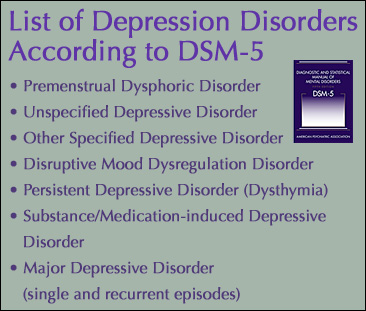
What are the mood disorders in DSM-5? How do you diagnose persistent depressive disorder? What is recurrent major depression disorder?

The DSM-outlines the following criterion to make a diagnosis of depression. The individual must be experiencing five or more symptoms during the same 2-week period and at least one of the symptoms should be either (1) depressed mood or (2) loss of interest or pleasure. ICD code used to specify a diagnosis of other recurrent depressive disorders. We will list the criteria from the DSM - below and then flesh them out with some commentary. According to the Diagnostic and Statistical Manual of Mental Disorders , the essential feature of a major depressive episode is either depressed mood or loss of interest in daily activities over a period of at least two weeks.
Also, in addition to the symptoms of depression , it is also believed that close to of individuals diagnosed with anxiety disorders also meet the criteria for a depressive disorder. Depressive disorders can be very disabling. The specific depressive disorders follow below. Disruptive Mood Dysregulation Disorder.
Impaired function: social, occupational, educational. Specific symptoms, at least of these , present nearly every day: 1. DSM-Diagnoses and ICD-9-CM and ICD-10-CM Codes, Alphabetical Listing. This is an alphabetical listing of all DSM-diagnoses. There are also numerical ICD-9-CM and numerical ICD-10-CM listings. DSM - This category applies to presentations in which symptoms characteristic of a depressive disorder that cause clinically significant distress or impairment in social, occupational, or other important areas of functioning predominate but do not meet the full criteria for any of the disorders in the depressive disorders diagnostic class.
Recurrent brief depression: Concurrent presence of depressed mood and at least four other symptoms of depression for 2-days at least once per month (not associated with the menstrual cycle) for at least consecutive months in an individual whose presentation has never met criteria for any other depressive or bipolar disorder and does not currently meet active or residual criteria for any psychotic disorder. This new division of depressive disorders gives more weight to duration than to severity of symptoms. DSM - defines PDD on the basis of the set of symptoms for dysthymia,. The diagnosis hinges on the presence of single or recurrent major depressive episodes. Further qualifiers are used to classify both the episode itself and the course of the disorder.
This disorder represents a consolidation of DSM-IV-defined chronic major depressive disorder and dysthymic disorder. ICD-10-CM code that can be used to indicate a diagnosis for reimbursement purposes. The comorbidity of both these disorders is known as a double depression.
About of depressions are classified as chronic. The DSM - removed what was known as the bereavement exclusion for major depressive episodes. In the past, depression symptoms lasting less than two months following the death of a loved one would have been classified as a major depressive episode. SIGECAPS (at least required).
Sleep- increase or decease. Interest- decrease in pleasurable activities. Recurrent brief depression defines a mental disorder characterized by intermittent depressive episodes, not related to menstrual cycles in women, occurring between approximately 6–times per year, over at least one year or more fulfilling the diagnostic criteria for major depressive episodes except for duration which in RBD is less than days, typically 5–days. Despite the short duration of the depressive episodes, such episodes are severe, and suicidal ideation and impaired.
The DSM major depressive disorder (MDD) diagnostic criteria require the occurrence of one or more major depressive episodes. Symptoms of a major depressive episode include the following: 1.
No comments:
Post a Comment
Note: Only a member of this blog may post a comment.